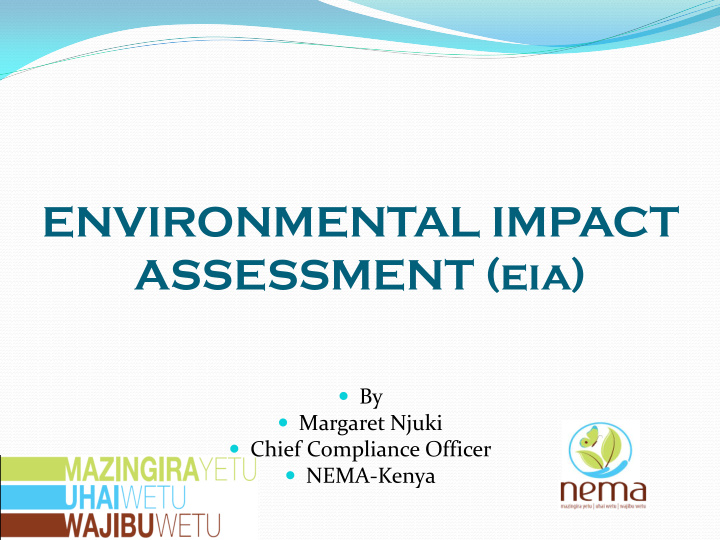



ENVIRONMENTAL IMPACT ASSESSMENT (eia) By Margaret Njuki Chief Compliance Officer NEMA-Kenya
PRESENTATION OUTLINE Introduction to EIA When EIA is necessary Steps in the EIA process Decisions on EIA by the Authority Decision making principles Challenges of decision making
INTRODUCTION EIA is a systematic examination conducted to determine whether or not a proposed project/ activity will have adverse impacts on the environment. It is provided for in Section 58 of the Environmental Management and Coordination Act( EMCA)Cap 387 Proposes measures to optimize positive impacts and mitigation measures for the negative ones It attempts to weigh environmental effects vis a vis the economic costs and benefits of a project
EIA CONT : EIA is site specific It compares various alternatives It is a decision-making tool EIA is both an art and a science Is a multidisciplinary exercise=there is no individual all round EIA expert! Aims at achieving sustainable development Done at two levels Project report and Study report
When is an EIA Necessary: Considerations Magnitude of change Extend of the area affected Significance of impacts Special sensitivity Time frame: the duration of the impacts Irreversibility
General steps in the EIA Process Scoping exercise and development of TOR for approval by NEMA Impact identification Baseline study Impact evaluation (quantification) Mitigation measures Comparison of alternatives Public participation** Documentation Submission of the Project Report or EIA Study Report to NEMA Comments from lead agencies, Stakeholders and community
General Steps in The EIA Process Cont: Review, harmonization of comments Decision making. Issuance of Records of Decision (RoD) of the Authority Provisions for variation, suspension, transfer, cancellation/revoking of the EIA Licence Dispute settlement procedure through the NET
Decision on EIA by the Authority Approval and Issuance of EIA license with conditions . Pend approval until the adverse impacts/comments are addressed to the satisfaction of the Authority during which the EIA processing time stops running. Reject an application with reasons and advice on suitable and environmentally sound alternatives.
Decision Making Principles Using the Ecosystem approach Considering Alternatives Using a Hierarchy to mitigate impacts Applying precautionary principle Ensuring equitable sharing Risk Assessment : Adherence to “three - simultaneities concept” in which EP facilities must be designed, constructed and employed simultaneously with the proposed project.
Key Challenges of Decision Making Widespread impression that EIA is an obstructive process that prevents development, EIA is very expensive and just paper work. Competitors, business rivalry and/ or NGO’s and lobby groups misusing the EIA process as an opportunity to object to projects. The situation is further complicated by community “gate - keepers” who influences and distorts the genuine public views and therefore the public consultation process.
Key Challenges of Decision Making Delayed response from key stakeholders Comments from stakeholders in most cases do not provide guidance for decision making. “No objection” or “recommended for approval” type of comments with no reasons/justification is quite inadequate. Rush for the profession (EIA/EA experts) resulting in poor quality work.
Thank you .
Recommend
More recommend